With its intoxicating fragrance, graceful buds and blooms and rich symbolism, the rose is perhaps the most beloved and culturally significant flower in human history.
Rose plants are woven into folklore and, of course, love and romance. (“Will you accept this rose?”). Classified under the genus Rosa, these regal woody perennials have captured hearts for centuries, spanning civilizations, continents and climates. In fact, the history of the rose is as regal as its stature.
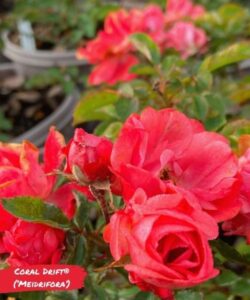
Coral Drift® (‘Meidrifora’) from Drift® Roses – Bright, coral-orange blossoms cover the small, mounding shrub from mid-spring to mid-fall.
Rooted in History
Roses may have existed more than 35 million years ago, according to fossil records. But it’s believed they were first cultivated in China about 5,000 years ago.
Ancient Greeks associated roses with Aphrodite, the goddess of love. Romans used rose petals to scent their bathwater and adorn banquets. In the Middle Ages, roses were used in medicine and in religious art.

Orange Glow™ Knock Out® (‘Radslam’) from the Knock Out® Family of Roses. Luminous orange flowers repeat-bloom from spring to frost.
Species Diversity
Roses belong to the Rosaceae family and although the species’ varieties are very diverse, they share a number of distinct characteristics. Most possess thorny stems, but not all varieties come heavily armed.
Rose foliage is typically pinnate with oval-shaped leaflets arranged symmetrically. Most roses maintain a core floral structure with five or more petals.
Flowers vary in size, shape and petal count, from single-petaled wild species to multi-layered hybrid blooms. They produce fruits called hips, which are rich in vitamin C.
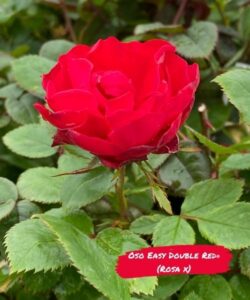
Oso Easy Double Red®(Rosa x) from Proven Winners. Lush, deep red blooms on long stems present a memorable display.
Within the species are classic hybrid teas and floribundas, shrub roses and climbers. The U.S. rose market is diverse, with more than 30,000 varieties available to growers, gardeners and collectors.
At Loma Vista Nursery, we specialize in growing healthy shrub varieties for our clients, which are Midwest independent garden centers, landscape contractors and wholesale distributors. Our rose varieties can be found in our online catalog, here.
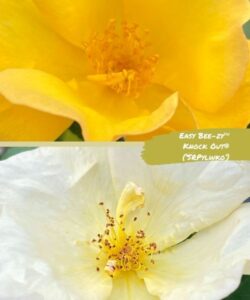
Easy Bee-zy™ Knock Out® (‘SRPylwko’) from the Knock Out® Family of Roses. Blooms yellow and open to white buttercream as they age.
Light & Soil Needs
To plant, begin with site selection. Roses thrive in at least six hours of direct sunlight every day. They prefer well-draining soil that is rich in organic matter. So, amend the soil with compost or aged manure to provide nutrients to the plant’s roots. This will encourage vigorous growth.
When placing the rose in the ground, look for the bulbous part of the stem. This is where the plant meets the rootstock. In warmer climates place this part of the plant slightly above the soil line. To prevent winter damage, plant it slightly below the soil line in colder areas.
Apply a 2- to 3-inch layer of organic leaf or shredded hardwood bark mulch to the soil around the plant’s base, taking care not to mound it or get it too close to the stem. This will help conserve moisture, suppress weeds and moderate soil temperature.
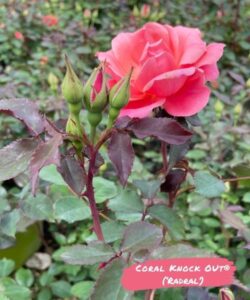
Coral™ Knock Out® (‘Radral’) from the Knock Out® Family of Roses. Blooms brick orange and fades to coral. This variety’s unique color is stronger in hot, humid climates.
Watering & Feeding
With good care, most rose varieties will bloom from spring to fall. Pay careful attention to watering and feeding.
Roses are heavy feeders and benefit from a consistent supply of nutrients throughout the growing season. A balanced fertilizer in spring, followed by a high-phosphorus blend during bloom-time, supports flower production.
Roses like watering that is deep and infrequent rather than sessions that are shallow and frequent. To encourage root development, water new plantings every three to four days. Water established plants once a week. Of course, you’ll want to water more frequently during hot, dry spells.

Petite Knock Out® (‘Meibenbino’) from the Knock Out® Family of Roses. Abundant blooms make this little shrub a perfect choice for decorative containers.
Landscape Designs & Gardens
Prune roses early in spring as new growth emerges. Remove dead, diseased or crossed branches to improve air circulation and direct the plant’s energy toward healthy canes. Removing spent blooms encourages repeat flowering and keeps roses looking tidy.
Aphids, black spot and powdery mildew are common pests and diseases. With attention and care, these issues can be managed through monitoring and by practicing organic, integrated pest control management.
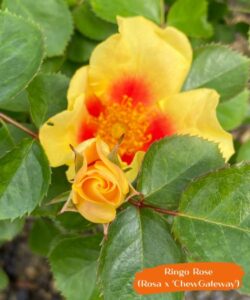
Ringo® Rose (Rosa x ‘ChewGateway’) from Proven Winners. Awash in sunny yellow blooms with bold red centers. As blooms age, they put on a colorful display, fading to white with a pink ring.
Whether you’re cultivating a few shrubs in the backyard or managing a full rose garden in a public display, the regal rose plant offers more than blooms. Roses offer connection to history as they deliver graceful, modern elegance to landscape designs and gardens.
Learn More About Loma Vista Nursery’s Landscape Plants
Loma Vista Nursery grows shrub roses and a variety of other flowering shrubs, perennial plants and trees for Midwest independent garden centers, landscape contractors and wholesale distributors. Our staff members – experts in the field – love helping people learn about plants and the healthy varieties we grow.
Ordering is underway for the trade industry! Review Loma Vista Nursery’s plant catalog for information and visit our website to learn about our values and best practices as a Midwest plant grower. For help with orders and plant-related questions, send an email to sales@lomavistanursery.com or call (785) 229-7200.
Connect with Us
Stay up-to-date on Loma Vista Nursery’s plant recommendations, species highlights, growing tips and more by following our blogs online and our posts on social media.
